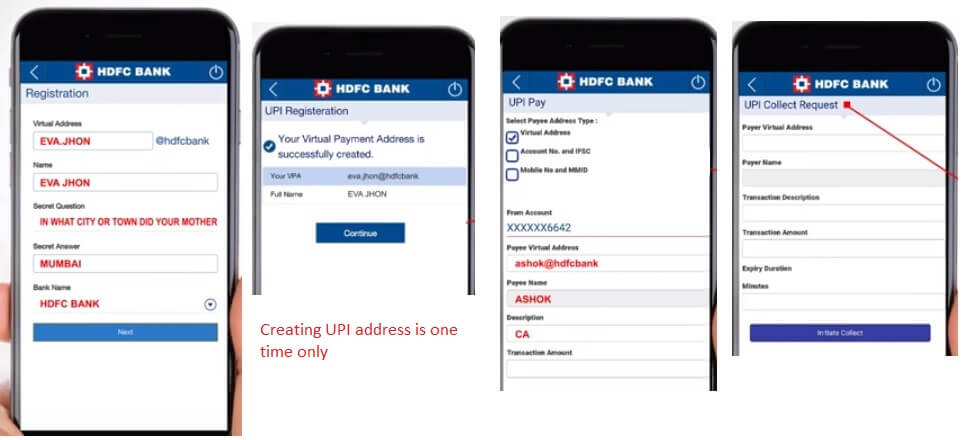The Reserve Bank of India on 29 Aug 2018, released its 245-page annual report for the financial year 2017-18. In the Annual Report, RBI spoke about a host of subjects like asset quality in the banking system, the government’s demonetisation exercise in 2016, the value of the Indian rupee, and India’s macros. Chapter IX, Payment and Settlement Systems and Information Technology, covers the Modes of Payment in India. This article covers the various Payment methods such as Cash, Cheque, NEFT, RTGS, IMPS that we can use in India, which methods are popular. It also compares the various payment methods.
Table of Contents
Payment Methods in 2017-18
The Reserve Bank’s endeavour to build a less-cash society continued with the large-scale adoption of digital modes of payments in the country. In 2017-18, non-cash transactions rose 45 per cent in volume and 29 per cent in value. The volume rate of growth, while lower than that in 2016-17, is higher than the average 25 per cent seen in the two fiscals prior to demonetisation. The trend is similar for value growth too.
As per the RBI annual report for 2017-18 for 2017-18 amongst the electronic modes of payments,
- The Real Time Gross Settlement (RTGS) system handled 124 million transactions valued at ₹1,167 trillion in 2017-18, up from 108 million transactions valued at ₹982 trillion in the previous year. At the end of March 2018, the RTGS facility was available through 1,37,924 branches of 194 banks.
- The NEFT system handled 1.9 billion transactions valued at around ₹172 trillion in 2017-18, up from 1.6 billion transactions valued at ₹120 trillion in the previous year, registering a growth of 20 per cent in terms of volume and 43.5 per cent in terms of value. At the end of March 2018, the NEFT facility was available through 1,40,339 branches of 192 banks, in addition to a large number of business correspondent (BC) outlets.
- Credit cards and debit cards: During 2017-18, the number of transactions carried out through credit cards and debit cards was 1.4 billion and 3.3 billion, respectively.
- Prepaid payment instruments (PPIs) recorded a volume of about 3.5 billion transactions, valued at ₹1,416 billion.
- Mobile banking services witnessed a growth of 92 per cent and 13 per cent in volume and value terms, respectively, while the number of registered customers rose by 54 per cent to 251 million at end-March 2018 from 163 million at end-March 2017.
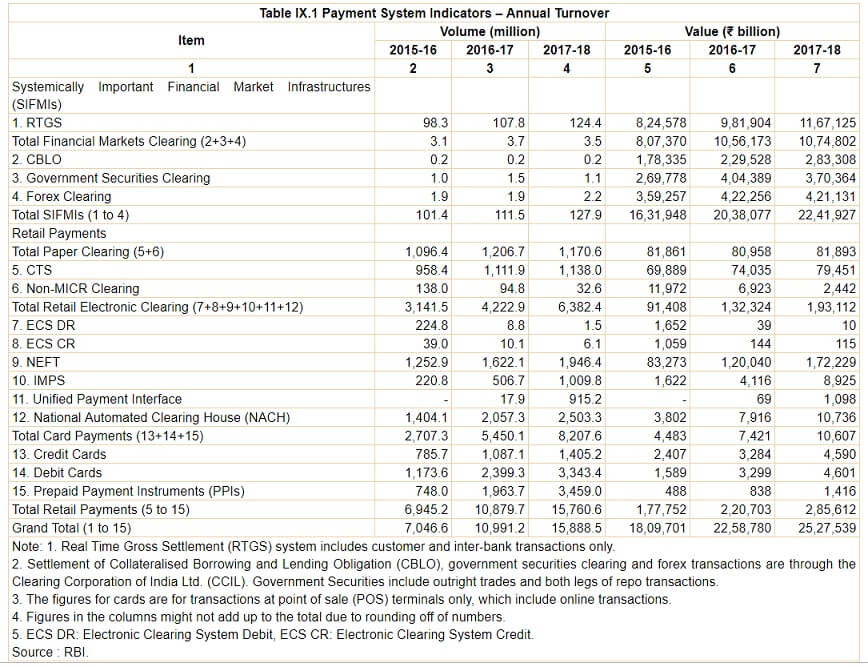
How India pays as per RBI annual report
Graphically it appears as follows
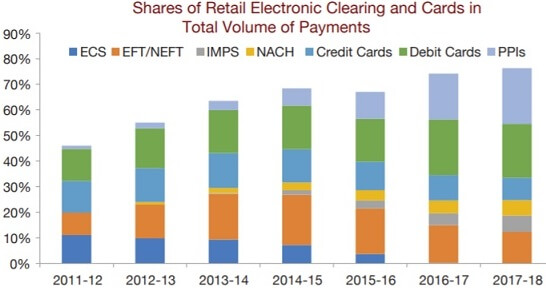
How Retail customers pay
Payment Methods in India
The payment system could be bifurcated into two main segments. The first segment consists of instruments which are covered under Systemically Important Financial Market Infrastructure (SIFMIs) and the second segment consists of Retail Payments, as shown in the image below. Under the Retail Payments segment which has a large user base, there are three broad categories of instruments. They are Paper Clearing, Retail Electronic Clearing and Card Payments.
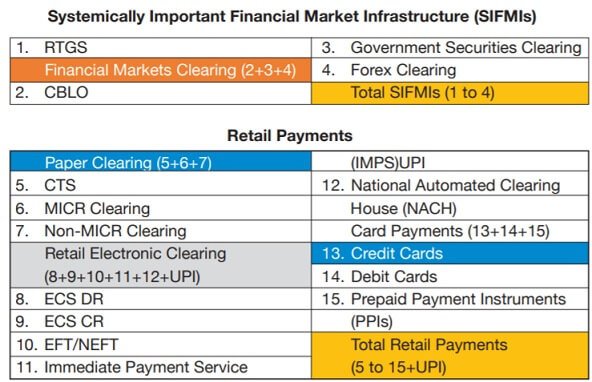
Payment methods in India
India’s payment system – particularly, its digital payments system – has been evolving robustly over the past many years, spurred by developments in information and communication technology, as envisioned by the Reserve Bank of India.
As part of this vision, the National Payments Corporation of India (NPCI) was established in 2008. It has been spearheading the development of the retail payments system. Important milestones attained in this overall process of development of the payments system include
- the introduction of MICR clearing in the early 1980s,
- Electronic Clearing Service and Electronic Funds Transfer in the 1990s,
- issuance of credit and debit cards by banks in the 1990s,
- the National Financial Switch in 2003 that brought about the interconnectivity of ATMs across the country,
- the RTGS and NEFT in 2004
- the Cheque Truncation System (CTS) in 2008, the second-factor authentication for the ‘card not present’ transaction in 2009
- the new RTGS with enhanced features in 2013
- Furthermore, non-bank entities have been introduced in the issuance of pre-paid instruments (PPI), including mobile and digital wallets. These measures have been complemented by significant initiatives by the NPCI including the launching of grid-wise operations of CTS, interoperability on NACH, IMPS, NFS, RuPay (a domestic card payment network), APBS and AEPS (which are an
important part of the financial inclusion process), the National Unified USSD Platform (NUUP), UPI and the BHIM application - Many of these achievements, particularly given their pan-India coverage, are indeed notable from a cross-country perspective, including the ‘T or T+1’ clearing of cheques enabled by CTS and the clearing house infrastructure, the NEFT, the IMPS, mobile banking/payments and the security aspects of card payments
Cheque Truncation System (CTS)
CTS or online image-based cheque clearing system is a cheque clearing system. As the name suggests, truncation is the process of stopping the flow of the physical cheque in its way of clearing. In its place, an electronic image of the cheque is transmitted with key
important data. Cheque truncation thus obviates the need to move physical instruments across branches and effectively eliminates the associated cost of movement of physical cheques, reduces the time required for their collection. The image below shows features of CTS cheque. For more details, you can refer to our article What is Cheque? How to write a cheque? Clearing of Cheque

Features of CTS 2010 Cheque
Non-MICR
The Non-MICR clearing refers to the process of manual clearing of cheques where the cheque is physically moved between the bank branches/banks for clearing. Unlike MICR clearing where the MICR code on the cheques is scanned and the transaction is
made, in MICR clearing the cheque is physically circulated for clearing.
ECS DR/CR
ECS is an electronic mode of payment/receipt for transactions that are repetitive and periodic in nature. ECS is used by institutions for making bulk payment or for bulk collection of amounts. Essentially, ECS facilitates a bulk transfer of monies from one bank account to many bank accounts or vice versa. ECS includes transactions processed under the National Automated Clearing House (NACH) operated by National Payments Corporation of India (NPCI).
NEFT
National Electronic Funds Transfer (NEFT) is a nation-wide payment system facilitating one-to-one funds transfer. Under this scheme, individuals, firms and corporates can electronically transfer funds from any bank branch to any individual, firm or corporate having an account with any other bank branch in the country participating in the scheme. Our article Third Party Fund Transfer: NEFT, RTGS explains it in detail.

NEFT Third party transfer
RTGS
Real Time Gross Settlement is defined as the continuous (real-time) settlement of funds transfers individually on an order by order basis (without netting). ‘Real Time’ means the processing of instructions at the time they are received rather than at some later time; ‘Gross Settlement’ means the settlement of funds transfer instructions occurs individually (on an instruction by instruction basis). This system is primarily meant for large value transactions. The minimum amount to be remitted through RTGS is Rs 2 lakh. For inter-bank fund transfer, there is no limit.
IMPS
Immediate Payment Service (IMPS) offers an instant 24X7 interbank electronic fund transfer service through mobile phones. IMPS is an emphatic tool to transfer money instantly within banks across India through mobile, internet and ATM. It is offered by National Payments Corporation of India (NPCI), India’s sole retail payment organization. Our article IMPS or Immediate Payment Service Send Money Instantly explains IMPS in detail.
UPI
Unified Payments Interface (UPI) is a system that powers multiple bank accounts into a single mobile application (of any participating bank), merging several banking features, seamless fund routing & merchant payments into one hood. It also caters to the “Peer
to Peer” collect request which can be scheduled and paid as per requirement and convenience. Our article What is Unified Payment Interface or UPI?How to use it? explains it in detail.
Credit Card
A credit card is a card issued by a financial company which one to borrow funds. The funds may be used as payment for goods and services, with a condition that the cardholder will pay back the original, borrowed amount plus any additional agreed-upon charges. The issuer pre-sets borrowing limits which have a basis on the individual’s credit rating. These cards can be used domestically and internationally and can also be used to withdraw cash from an ATM. Our article How Credit/Debit card is Verified when it is Swiped? covers swiping of a credit card in detail.
Debit Card
A debit card is a payment card that deducts money directly from a consumer’s bank account to pay for a purchase and eliminate the need to carry cash or physical checks to make purchases. In addition, they offer the convenience of credit cards and many of the same consumer protections when issued by major payment processors like Rupay, Visa or MasterCard, but unlike credit cards, they do not allow the user to go into debt.
Pre-paid Payment Instruments (PPIs)
Pre-paid Payment Instruments (PPIs) are defined as payment instruments that facilitate the purchase of goods and services, including funds transfer, against the value stored on such instruments. The value stored on such instruments represents the value paid for by the holders by cash, by debit to a bank account, or by credit card. The pre-paid instruments can be issued as smart cards, magnetic stripe cards, internet accounts, internet wallets, mobile accounts, mobile wallets, paper vouchers and any such instrument which can be used to access the pre-paid amount.
The maximum value of any pre-paid payment instrument (where specific limits have not been prescribed) cannot exceed Rs 50,000/ (as on October 2015) and they have a minimum validity period of six months from the date of activation/issuance to the holder.
Compare payment options
Image below compares various payment options.
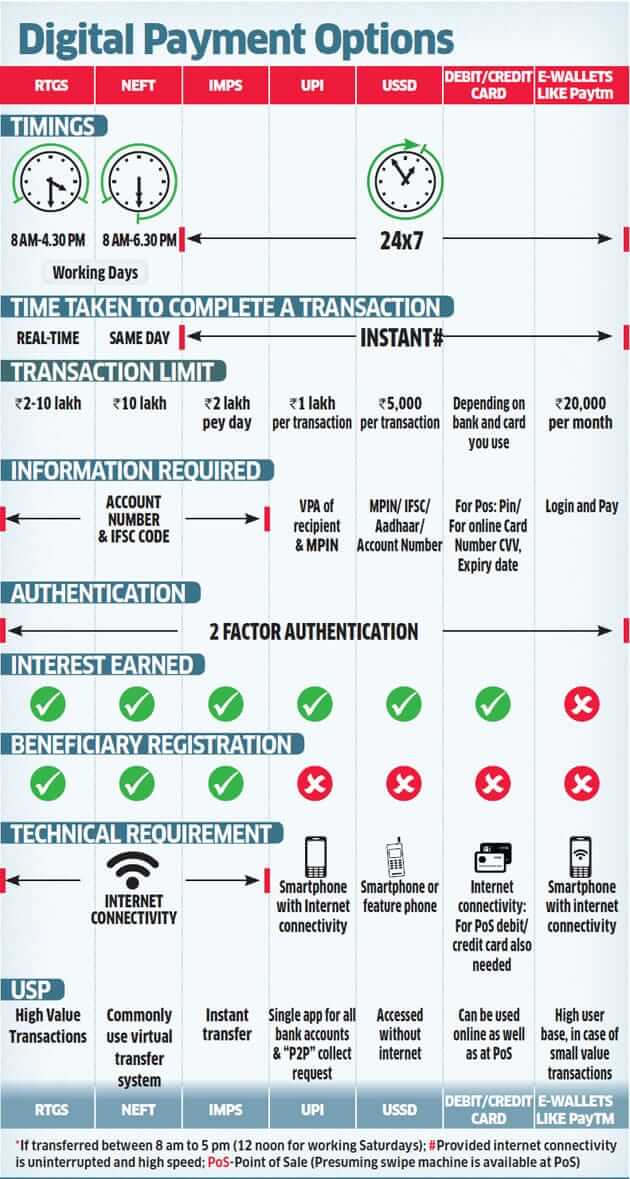
Compare Payment Options
Related Articles:
- What are Central Banks,What is RBI? What do they do?
- How Credit Card Number is Verified Online Using CVV2
- How to use IMPS to send money instantly
- IFSC, MICR, SWIFT Code, Difference between IFSC and MICR, IFSC and SWIFT
- Difference between NEFT, RTGS, IMPS, UPI
- WhatsApp Payment: How to use Whats App to Send Money
